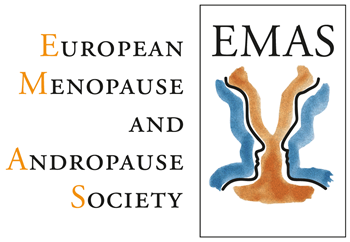Host: Welcome to today’s podcast Effects of estrogen deficiency on sexual life. This episode is part of a podcast series supported by Abbott. The content is solely the responsibility of EMAS, the European Menopause and Andropause Society. All our episodes are available in English, Spanish, Mandarin, and Russian and you can find them on any of the most popular podcast platforms.
In today’s episode Dr. Rossella Nappi, Gynecologist and professor at the University of Pavia, IRCCS San Matteo Foundation Hospital, Pavia, Italy will help us understand the effect of estrogen deficiency on sexual health, as well as the importance of treating vulvovaginal atrophy/genitourinary syndrome of menopause (VVA/GSM) with local estrogen therapies (LET).
Dr. Rossella Nappi: Hello. I’m Professor Nappi from the University of Pavia, Italy. And it’s my pleasure today to talk to you about the effects of estrogen deficiency on sexual life. Estrogens play a pivotal role in several areas of women’s health and profoundly affect urogenital and sexual health. Vulvovaginal atrophy, the so-called VVA, is part of the genitourinary syndrome of menopause, that we now name with the acronym, GSM. VVA or GSM are almost due to the decline of estrogen production by the ovaries. It’s very relevant to consider the effect of estrogen within the central nervous system and at the peripheral levels of the genitals in order to understand their role in sexual life.
What happens in the central nervous system? Estrogens target brain areas critical to emotional and cognitive well-being. And sexual symptoms are likely to be the result of the domino effect of menopausal complaints. It is very important to know that most of the neurotransmitters and neuromodulators contributing to the mental component of sexual response are involved in other central nervous system adjustments, influencing also mood and behavioral responses to menopause.
But what happens in the genitals? Estrogens target peripheral tissues to translate sexual cues into physical arousal. Estrogens are also vital for the functional anatomy of urogenital tissues. Favoring congestion and lubrication with arousal and preventing signs and symptoms of a VVA, you remember recently renamed GSM. And this includes not only the effect of estrogen deficiency but also the effect of aging and androgen deprivation. The crucial role of estrogen, however, is demonstrated by the fact that local estrogen therapy is the mainstay of treatment for vaginal dryness, dyspareunia, and other GSM-associated urogenital symptoms. This is because it may reverse some pathophysiological mechanisms of this common chronic clinical condition. When a hormonal over-the-counter symptomatic relief products fail and no other menopausal symptoms are present, expert recommendations indicate the use of local estrogen therapy with level A evidence. Also, we have to keep in mind that systematic, sorry, systemic menopause hormone therapy improves symptoms of GSM in most menopausal women. However, its risk-benefit profile is acceptable for this purpose when other indications, mainly, vasomotor symptoms or prevention of osteoporotic fractures represent the main reason for prescription.
Combination of menopausal hormone therapy and local therapy may be required initially for women with severe symptomatology. A subset of patients that are breast cancer survivors, for example, display contraindications to menopause hormone therapy, and treatment of GSM may remain an unmet need, unless local estrogen therapy is prescribed with an individualized approach. Local estrogen therapy includes a range of vaginal estrogen products approved with indications to treat symptomatic VVA. Subject to rating scales of the most bothersome symptoms, dryness, soreness, irritation, pain with intercourse, bleeding after intercourse, and objective measures, including vaginal pH and vaginal cytology are useful tools to evaluate response to local estrogen therapy. They exert a traffic effect very evident on the vaginal epithelium and blood flow, but we have to consider the distribution of estrogen receptors is also present at lower urinary tract levels and also in the vulvar area. Availability of specific vaginal products varies worldwide and include many formulations, tablets, strings, capsule, pessaries, creams, gels, and ovules, and also many molecules, estradiol, estriol, promestriene, conjugated equine estrogen and even estrone. And they have been tested over time. More or less, they are equally effective.
At present, low-dose and ultra-low-dose local estrogen therapy is the first choice in order to minimize systemic absorption. Different formulations are typically used daily for two weeks, followed by twice-per-week administration. The ring, for example, is replaced every 90 days. Estrogenic absorption is dose-dependent and also, it’s very important to remember that positioning in the vagina as well, the thickness of the epithelium may influence systemic exposure. Especially in the first 12 weeks of treatment. In conclusion, ladies and gentlemen, it’s important to mention that early local estrogen therapy used alone or combined with menopause hormone therapy in post-menopausal women with GSM symptom severity is of paramount importance in the management of urogenital aging in order to improve quality of life and sexual well-being. And it’s mandatory, in my view, to investigate nowadays specific effects of different products on quality of life, sexual function and genital urinary condition by conducting studies with the patient tailored focus.
Host: Today, Dr. Rossella Nappi discussed the effect of estrogen deficiency on sexual life, as well as the importance of treating vulvovaginal atrophy/genitourinary syndrome of menopause (VVA/GSM) with local estrogen therapies (LET). Thank you for listening to today’s episode. We hope it will be valuable for your clinical and research practice. Stay safe.
[END]


